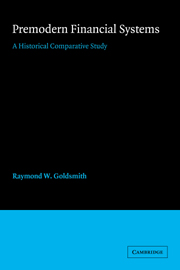Book contents
- Frontmatter
- Contents
- List of tables
- Preface
- 1 Introduction
- 2 The financial systems of the ancient Near East
- 3 The financial system of Periclean Athens
- 4 The financial system of Augustan Rome
- 5 The financial system of the early Abbasid caliphate
- 6 The financial system of the Ottoman Empire at the death of Suleiman I
- 7 The financial system of Mughal India at the death of Akbar
- 8 The financial system of early Tokugawa Japan
- 9 The financial system of Medici Florence
- 10 The financial system of Elizabethan England
- 11 The financial system of the United Provinces at the Peace of Münster
- 12 Similarities and differences
- Notes
- Bibliography
- Index
4 - The financial system of Augustan Rome
Published online by Cambridge University Press: 05 March 2012
- Frontmatter
- Contents
- List of tables
- Preface
- 1 Introduction
- 2 The financial systems of the ancient Near East
- 3 The financial system of Periclean Athens
- 4 The financial system of Augustan Rome
- 5 The financial system of the early Abbasid caliphate
- 6 The financial system of the Ottoman Empire at the death of Suleiman I
- 7 The financial system of Mughal India at the death of Akbar
- 8 The financial system of early Tokugawa Japan
- 9 The financial system of Medici Florence
- 10 The financial system of Elizabethan England
- 11 The financial system of the United Provinces at the Peace of Münster
- 12 Similarities and differences
- Notes
- Bibliography
- Index
Summary
The infrastructure
The early Roman Empire with a settled territory of about 3.3 million km2, including all countries bordering the Mediterranean and a population of about 55 million, was the largest political, economic, and monetary unit in the Western World until the nineteenth century, and in these terms probably was not surpassed by its only two competitors, the Chinese and Indian empires, until about a.d. 1000. This chapter will concentrate on the situation at the death of Augustus (a.d. 14). However, because of the slow tempo of changes in most fields, the discussion may in general be read as applicable to the century from the beginning of the principate (28 b.c.) to the death of Domitian (a.d. 96). The discussion may also be regarded as applying to most provinces, except Egypt which had a considerably lower level of prices and nominal incomes and a higher level of interest rates.
Population
The Roman Empire at the death of Augustus appears to have had a population of between 50 and 60 million people, or only 15 to 18 per km2, divided about equally between its western and eastern provinces. There is no evidence of a substantial net change over the first two centuries of the empire as a whole, though there may have been a small increase in the first and a small decrease in the second century.
- Type
- Chapter
- Information
- Premodern Financial SystemsA Historical Comparative Study, pp. 34 - 59Publisher: Cambridge University PressPrint publication year: 1987



